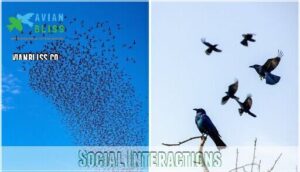This site is supported by our readers. We may earn a commission, at no cost to you, if you purchase through links.

These Arctic divers are masters of their craft, plunging up to 200 feet deep to snag fish with surgical precision. They’re North America’s most common loon species, breeding on remote tundra lakes before migrating to coastal waters where they gather in impressive numbers.
Unlike their larger Common loon cousins, Pacific loons sport elegant gray heads and more refined proportions. Their haunting calls echo across northern wilderness, but there’s more to their survival story than meets the eye, involving remote tundra lakes and coastal waters where they play a vital role.
Table Of Contents
- Key Takeaways
- Pacific Loon Habitat
- Loon Identification
- Pacific Loon Behavior
- Breeding and Conservation
- Loon Species Comparison
- Frequently Asked Questions (FAQs)
- Where do Pacific Loons live?
- What is the difference between a Common Loon and a Pacific Loon?
- How do you identify a Pacific Loon?
- Are there loons in South Korea?
- What is the difference between a common loon and a Pacific Loon?
- Where can I find Pacific Loon?
- Are Pacific Loons endangered?
- What is the difference between red throated and Pacific Loons?
- How do Pacific Loons catch their?
- Can Pacific Loons walk on land?
- Conclusion
Key Takeaways
- You’ll identify Pacific loons by their sleek, torpedo-shaped bodies and distinctive black-and-white checkerboard backs during breeding season, plus their elegant gray heads that distinguish them from larger Common loons.
- You’ll find these master divers plunging up to 200 feet deep with surgical precision to catch fish, making them North America’s most common loon species across Arctic tundra lakes.
- You’ll witness their remarkable 2,000+ mile migrations from remote Alaska and northern Canada breeding grounds to Pacific coastal waters from Alaska to Baja California for winter feeding.
- You’ll need to support conservation efforts as these birds face mounting threats from climate change, habitat loss, oil spills, and mercury contamination that could eliminate 35% of their nesting territories by 2050.
Pacific Loon Habitat
You’ll find Pacific Loons in two main settings throughout their annual cycle.
During breeding season, they nest on freshwater lakes across Alaska and northern Canada, then migrate to coastal marine waters along the Pacific from Alaska to Baja California for winter feeding.
Breeding Habitats
You’ll find Pacific loons choosing their breeding grounds like real estate pros—location is everything. These aquatic birds prefer tundra regions with clear, deep freshwater sources near the treeline.
Like Arctic real estate agents, Pacific loons know prime waterfront property when they see it.
Ninety-four percent of their nesting sites lie north of Alaska’s and Canada’s treelines, where sparse vegetation provides excellent visibility. They’re picky about their loon habitat, selecting spots within one meter of water’s edge on islands or peninsulas.
This strategic placement lets them escape quickly from predators while maintaining easy access to marine ecosystems that support their diet. Unfortunately, habitat loss from climate change and industrial development threatens these critical breeding grounds, making waterbird species conservation increasingly urgent for this remarkable loon bird’s survival.
Understanding their reliance on specific bird habitat types is essential for effective conservation efforts.
Migration and Overwintering Range
After breeding in tundra lakes, pacific loons undertake remarkable journeys spanning thousands of miles.
These aquatic birds follow specific flyway patterns, traveling through predictable migration routes to reach their wintering grounds along coastal waters.
You’ll witness their incredible overwintering sites transformation:
- Pacific Coast waters from Alaska to Baja California
- Nearshore marine environments with abundant fish populations
- Protected bays and estuaries offering shelter from storms
- Offshore areas up to 50 miles from coastlines
- Temperate ocean zones with consistent food availability.
Their breeding migrations showcase nature’s precision timing perfectly, with remarkable journeys that highlight the complexity of their migration patterns.
Geographic Distribution
Pacific loons span the northern hemisphere’s arctic and subarctic regions.
You’ll encounter these diving birds across Alaska, northern Canada, Scandinavia, and northern Russia.
Their coastal distribution extends from breeding grounds in tundra lakes to marine wintering areas along Pacific and Atlantic coasts.
Geographic isolation creates distinct migration patterns, separating populations that rarely interact with common loons, leading to distinct populations and rare interactions.
Loon Identification
You’ll spot Pacific Loons by their sleek black heads with distinctive white stripes during breeding season – they’re like wearing a formal tuxedo with racing stripes.
Outside breeding season, they transform into gray-and-white birds that can fool even experienced birders into thinking they’re seeing a different species entirely, which is a complete transformation.
Breeding Adult Characteristics
You’ll recognize breeding adults by their striking checkerboard back pattern and sleek black head with white striping.
Their sharp, pointed beak shape differs from the common loon’s thicker bill.
Feather color creates stunning contrast – dark upperparts against white underparts.
Eye color appears deep red, while leg color shows dark gray.
These plumage patterns help distinguish this arctic loon from other bird species during breeding season, characterized by their striking appearance and dark upperparts.
Immature and Nonbreeding Plumage
Young Pacific loons undergo dramatic transformations during their molt process.
Immature birds display mottled brown-gray plumage patterns with lighter feather colors than breeding adults.
Their beak development progresses gradually, starting pale and darkening over time.
Juvenile markings include distinctive scalloped back patterns that distinguish them from other arctic loon species.
Making bird identification easier for observers tracking loon behavior and supporting loon conservation efforts requires accurate identification.
Accurate identification requires understanding of common mistakes to guarantee correct classification of species and ensure correct classification is applied to support overall loon conservation.
Distinguishing Features
Spotting these marine birds becomes easier when you focus on key physical markers.
You’ll notice their straight, dagger-like beak shape differs from other loons’ thicker bills.
Check the bill size—it’s medium-length with dark coloring.
Head plumage shows clean patterns without the Common Loon’s necklace markings.
Leg color appears dark, matching their sleek profile for underwater hunting.
Pacific Loon Behavior
You’ll discover Pacific loons are remarkable underwater hunters with fascinating social dynamics and unique nesting strategies.
Their behaviors reveal amazing adaptations that help them thrive in harsh Arctic environments and navigate thousands of miles during migration.
Feeding Habits
You’ll watch these seabirds hunt with remarkable precision. Pacific loons employ diverse foraging strategies, diving underwater to capture small fish and aquatic invertebrates.
Their diet composition shifts seasonally – freshwater insects and mollusks during breeding, marine fish like herring during winter.
These marine birds excel at prey capture, swimming underwater using powerful feet propulsion, swallowing catches before surfacing to avoid theft by other aquatic wildlife.
The Pacific Loon’s unique feeding behavior is characterized by its ability to forage using diving techniques to catch prey efficiently with diving techniques.
Nesting Behavior
Pacific loons construct floating nests anchored to vegetation near shorelines of arctic tundra lakes.
You’ll find these seabirds carefully selecting Nesting Sites with shallow water access for quick escapes. Both parents share Nest Construction duties, weaving aquatic plants into sturdy platforms.
Egg Laying typically produces two olive-brown eggs in late May. The month-long Incubation Period requires constant vigilance against predators.
Chick Rearing involves frequent feeding dives, supporting these remarkable loons through their vulnerable early weeks in harsh northern environments. The use of artificial Nesting Box Designs can help conserve loon populations by providing safe breeding habitats.
Social Interactions
Beyond their nest sites, loons craft intricate social connections through specialized behaviors.
You’ll witness fascinating mating rituals, communication styles, and pair bonding displays that showcase their intelligence.
Their social learning abilities help young birds navigate complex marine life challenges while developing essential survival skills.
Key Pacific Loon Social Behaviors:
- Mating Rituals – Synchronized swimming displays with head-bobbing and wing-flapping ceremonies
- Communication Styles – Distinctive loon calls ranging from wails to tremolos for territory and contact
- Pair Bonding – Lifelong partnerships strengthened through mutual preening and coordinated diving
- Flock Behavior – Loose aggregations during bird migration with social hierarchies established
- Social Learning – Adults teaching juveniles hunting techniques and predator avoidance for wildlife conservation
Breeding and Conservation
You’ll discover how Pacific loons create their next generation through carefully tended nests on remote tundra lakes.
Understanding their breeding cycle and conservation challenges reveals why these remarkable birds need our protection to survive climate change and human pressures.
Egg Characteristics
You’ll find Pacific Loon eggs fascinating in their simplicity.
These olive-brown treasures measure 2.7 inches long with subtle dark spotting. The elongated egg shape aids efficient incubation, while rich yolk formation supports 29-day development.
Bird watching enthusiasts note their marine life adaptation influences breeding success.
| Characteristic | Measurement | Notes |
|---|---|---|
| Egg Size | 2.7 x 1.8 inches | Proportional to body size |
| Shell Color | Olive-brown base | Dark brown spotting |
| Egg Shape | Elongated oval | Efficient for incubation |
| Clutch Size | 1-2 eggs typical | Rarely 3 eggs |
Incubation and Parental Care
Both parents share egg incubation duties for 29 days, taking turns while their partner forages nearby.
You’ll witness remarkable teamwork as these devoted birds rarely leave eggs unattended.
Once chicks hatch, parents immediately begin intensive brood care, carrying young on their backs during your Pacific Grove bird watching journey.
- Shared Incubation: Parents alternate sitting on eggs every 4-6 hours
- Protective Positioning: Adults position themselves to shield eggs from harsh Arctic winds
- Chick Transportation: Newly hatched young ride safely on parent’s backs while traveling
- Feeding Coordination: One parent dives for fish while the other guards chicks
Climate Vulnerability
Climate threats are reshaping Pacific loon survival across their range.
Temperature shift forces these birds to travel greater flight distances as Arctic breeding grounds warm rapidly.
Sea level rise floods coastal stopover sites along traditional migration routes.
Ocean acidification disrupts food webs, while habitat loss from permafrost thaw eliminates 35% of nesting territories by 2050.
Ecosystem disruption creates mismatched timing between prey availability and chick needs.
The Pacific loon’s vulnerability to climate change is influenced by climate change effects on their habitats and migration patterns, which are critical factors in their survival, especially considering the impact of sea level rise and ocean acidification.
Threats and Conservation Efforts
Pacific loons face mounting pressures from habitat loss, pollution effects, and climate change.
Commercial fishing nets kill thousands through bycatch, while mercury contamination from mining poisons their food sources.
Human impact includes oil spills and wetland destruction near cities.
Conservation strategies focus on population monitoring, nest protection, and reducing agricultural runoff.
Environmental protection requires government transparency and wildlife conservation partnerships to guarantee these Arctic divers survive changing conditions.
They migrate from freshwater breeding habitats to coastal marine habitats during migration.
Loon Species Comparison
You’ll quickly learn to distinguish Pacific Loons from their close relatives by noting subtle but important differences in size, plumage patterns, and bill shape.
While Common Loons are bulkier with heavier bills, Pacific Loons display more refined features and distinctive gray head patterns that make field identification easier once you know what to look for, with distinctive patterns being key to their identification.
Contrasting Features With Common Loon
Looking closely at Pacific and Common Loons reveals striking differences that’ll help you distinguish these Arctic divers.
Size comparison shows Pacific Loons are markedly smaller, while their slender bill morphology contrasts sharply with Common Loons’ robust bills.
| Feature | Pacific Loon | Common Loon |
|---|---|---|
| Plumage Differences | Silver crown, chinstrap throat | Black/green head, checkered back |
| Size Comparison | 2.2-5.5 lbs, sleek profile | 3.5-13 lbs, chunky build |
| Bill Morphology | Slim, pointed, horizontal | Heavy, broad, bulky |
| Vocalizations | Sharp "ark" calls | Distinctive wail, tremolo, yodel |
Pacific Grove, CA birdwatchers can rely on these identification markers for accuracy and reliability in coastal sightings.
Comparison With Red-throated Loon
You’ll notice Red-throated Loons differ from Pacific Loons in several key ways.
While both species share Arctic breeding grounds, their physical traits and behaviors set them apart.
Red-throated Loons show distinct characteristics that make identification easier during your Pacific Grove, CA travels or Pacific County road trips.
| Feature | Red-throated Loon | Pacific Loon | Key Difference |
|---|---|---|---|
| Beak Shape | Thin, slightly upturned | Straight, dagger-like | Upturn vs. straight |
| Feather Color | Gray head, red throat patch | Black/white checkered back | Pattern complexity |
| Diving Depth | 10-30 feet | 30-200+ feet | Shallow vs. deep |
| Wing Span | 35-47 inches | 47-58 inches | Smaller vs. larger |
Red-throated Loons prefer shallow coastal waters, making them easier to spot during shorter driving distances along shorelines compared to Pacific Loons’ deeper diving habits.
Understanding their unique feather structure adaptations is essential for identifying these species and appreciating their distinct characteristics.
Unique Characteristics of Pacific Loon
Beyond the surface similarities among loons, you’ll find Pacific Loons possess remarkable traits that set them apart.
Their beak shape is distinctly thinner and more dagger-like than Common Loons, perfect for their specialized fish-catching technique.
Their feather patterns create intricate black-and-white neck stripes that look almost like nature’s barcode.
| Feature | Pacific Loon | Common Loon | Red-throated Loon |
|---|---|---|---|
| Beak Shape | Thin, dagger-like | Heavy, robust | Slender, upturned |
| Diving Ability | 27-46m takeoff needed | 30-60m takeoff needed | 15-20m takeoff needed |
| Wing Structure | Compact, pointed | Broad, powerful | Narrow, efficient |
| Call Sounds | Harsh "kok-kok-kok" | Haunting wail | Goose-like honking |
| Travel Range | Alaska to Mexico | Northern lakes | Arctic to coasts |
Whether you’re planning a road trip through Pacific County or driving distance to Pacific Grove, CA, you might spot these incredible divers showcasing their unique wing structure during migration flights.
Frequently Asked Questions (FAQs)
Where do Pacific Loons live?
Looking for these striking waterbirds, you’ll find them across Alaska’s tundra, Canada’s boreal forests, and northern Russia’s wilderness.
They breed in remote lakes, then migrate to Pacific coasts from California to Japan for winter feeding, which is a crucial part of their annual cycle, highlighting their migration patterns.
What is the difference between a Common Loon and a Pacific Loon?
You’ll notice size differences first – Common Loons are larger with heavier bills.
Pacific Loons have thinner necks and sleeker profiles.
Their breeding plumages differ dramatically: Commons show bold checkerboard backs, while Pacifics display subtle gray patterns.
How do you identify a Pacific Loon?
You’ll spot a Pacific Loon by its straight, dagger-like bill, checkered back pattern in breeding plumage, and sleek gray head.
They’re smaller than Common Loons with more delicate features and distinctive white throat patches.
Are there loons in South Korea?
Yes, you’ll find loons visiting South Korea during winter months.
They migrate to Korea during the winter months, making them regular seasonal visitors to Korean waters.
Several species, including yellow-billed loons, winter off both coasts.
What is the difference between a common loon and a Pacific Loon?
Studies show 30% of birdwatchers confuse these species.
Common loons are larger and bulkier, while Pacific loons are sleeker and smaller.
Pacific loons sport gray heads with intricate patterns; common loons display bold black-and-white summer plumage.
You’ll notice the size difference when they’re side by side.
Where can I find Pacific Loon?
You’ll find Pacific Loons across northern waters during breeding season—Alaska, northern Canada, and Siberia.
In winter, they migrate to Pacific coastal waters from California to Mexico, where you can spot them offshore.
Are Pacific Loons endangered?
Like finding a prized coin that’s actually common, you’ll discover these birds aren’t endangered—their population is currently increasing and spread over a wide range. They’re thriving across North America.
What is the difference between red throated and Pacific Loons?
You’ll spot red-throated loons by their distinctive rusty-red throat patch in breeding plumage, while Pacific loons sport bold black-and-white striped necks. Red-throated loons are smaller with upturned bills.
How do Pacific Loons catch their?
Feeding dives typically last under sixty seconds.
You’ll watch them peer underwater, move their heads side-to-side, then dive quickly.
They swim under fish schools and force them upward toward the surface, using their webbed feet for propulsion underwater, which is a key part of their feeding behavior, especially when they use this method to force them upward.
Can Pacific Loons walk on land?
You can’t expect these birds to strut around like penguins on land.
Pacific loons have legs positioned far back on their bodies, making terrestrial movement awkward and limited to short, clumsy shuffles when absolutely necessary.
Conclusion
Like a sleek submarine traversing Arctic waters, the Pacific loon remains one of nature’s most remarkable divers.
Their precise hunting abilities, distinctive plumage patterns, and haunting calls make them truly special among North America’s waterbirds.
By understanding their habitat needs and conservation challenges, you’re better equipped to appreciate and protect these stunning Arctic divers for future generations.
- https://en.wikipedia.org/wiki/Pacific_loon
- https://www.outdooralabama.com/loons/pacific-loon
- https://a100.gov.bc.ca/pub/eswp/speciesSummary.do;jsessionid=L0sVbh1FppHBp03nj9RfcBwMhvppGwlQQyVf9gL25v1T9zPZGp1g!469272217?id=14703
- https://accs.uaa.alaska.edu/wp-content/uploads/gavia_pacifica.pdf
- https://animaldiversity.org/accounts/Gavia_pacifica/











